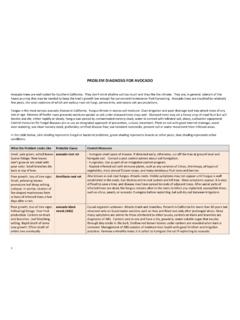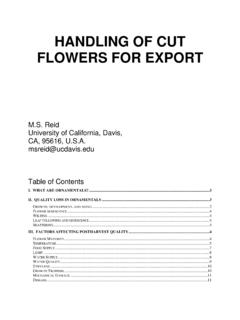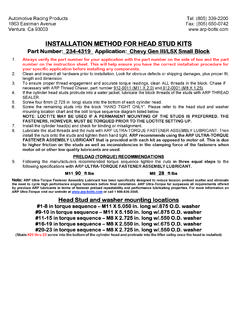Transcription of Effect of ethylene on quality of fresh fruits and vegetables
1 Postharvest Biology and Technology 15 (1999) 279 292 Effect of ethylene on quality of fresh fruits and vegetablesMikal E. Saltveit *Mann Laboratory,Department of vegetable Crops,Uni6ersity of California,One Shields A6e.,Da6is,CA95616-8631,USAR eceived 10 June 1998; received in revised form 28 October 1998; accepted 11 November 1998 AbstractEthylene is a naturally occurring plant growth substance that has numerous effects on the growth, development andstorage life of many fruits , vegetables and ornamental crops atmll 1concentrations.
2 Harvested fruits and vegetablesmay be intentionally or unintentionally exposed to biologically active levels of ethylene and both endogenous andexogenous sources of ethylene contribute to its biological activity. ethylene synthesis and sensitivity are enhancedduring certain stages of plant development, as well as by a number of biotic and abiotic stresses. Exposure may occurinadvertently in storage or transit from atmospheric pollution or from ethylene produced by adjacent exposure is primarily used to ripen harvested fruit .
3 The detrimental effects of ethylene on quality centeron altering or accelerating the natural processes of development, ripening and senescence, while the beneficial effectsof ethylene on quality center on roughly the same attributes as the detrimental effects, but differ in both degree anddirection. Care must therefore be taken to insure that crops sensitive to the effects of ethylene are only exposed tothe desired atmosphere. A number of techniques to control the effects of ethylene are discussed in relation to theirapplication with commercially important fruits and vegetables .
4 Examples of general and specific beneficial anddetrimental ethylene effects are given. 1999 Elsevier Science All rights :Appearance; Aroma; Color; ethylene synthesis and action; Flavor; Storage; Taste1. IntroductionBoth the practical agricultural use of ethylene (C2H4), and the basic biochemistry and physiol-ogy of C2H4have been extensively studied formany decades (Abeles et al., 1992). Elucidation ofthe C2H4biosynthetic pathway by Adams andYang (1979) and the recent application of molecu-lar biology to unravel the complexities of C2H4biosynthesis and action have greatly stimulatedresearch in this area (Yang, 1985; DellaPenna andGiovannoni, 1991; Grierson and Schuch, 1994;Kanellis et al.)
5 , 1997). However, much of what isknown about the effects of C2H4on the quality offresh fruits and vegetables has been slowly* Tel.: 1-530-752-1815; fax: 1-530-752-4554; - see front matter 1999 Elsevier Science All rights :S0925-5214(98) :Posthar6est Biology and Technology15 (1999) 279 292280amassed since the 1920s, and needs constant up-dating. The introduction of new cultural practices,cultivars, harvest and handling methods, posthar-vest treatments, consumer products and packag-ing influence the Effect C2H4has on qualityattributes.
6 Continued research in these areas,though not as glamorous as in biotech. areas,provides the foundation upon which the commer-cial agricultural use of C2H4is based. The infor-mation presented in this review has been gleanedfrom recent publications and from past reviews onthe biochemistry and physiology of C2H4(Abeleset al., 1992; Kanellis et al., 1997; Saltveit et al.,1998), its role in postharvest handling (Kader,1985; Weichmann, 1987; Yang, 1987), and itseffect on food quality (Watada, 1986; Lougheedet al.)
7 , 1987). ethylene is a naturally produced, simple twocarbon gaseous plant growth regulator that hasnumerous effects on the growth, development andstorage life of many fruits , vegetables and orna-mental crops (Table 1). This powerful plant hor-mone is effective at part-per-million (ppm,mll 1)to part-per-billion (ppb, nl l 1) the synthesis and action of C2H4involvecomplicated metabolic processes, which requireoxygen and are sensitive to elevated concentra-tions of carbon dioxide. Endogenous sensitivity toC2H4changes during plant development, as doesTable 2 Plant responses to ethyleneEthylene stimulatesSynthesis of C2H4in ripening climacteric of ( anthocyanin) destruction and root of inhibitsEthylene synthesis in vegetative tissue and development in most and root elongation (growth).
8 Normal orientation of cell wall rate of synthesis and loss by diffusion from responses to endogenously produced andexogenously applied C2H4are numerous andvaried (Table 2), and are only beneficial or detri-mental when viewed anthropomorphicly (Table3). For example, effects that are viewed as benefi-cial include the promotion of flowering in pineap-ple (Ananas comosus) and the hastening ofripening in tomato (Lycopersicon esculentum) andmelons (Cucumis melo). Effects that are viewed asdeleterious include the abortion of flowers and thedevelopment of russet spotting in lettuce (Lactucasati6a).
9 Often the same response ( accelerationTable 1 Biological attributes of ethyleneColorless gas at biological occurring organic diffuses within and from from methionine via ACC by a highly regulatedmetabolic enzymes are ACC synthase and ACC synthesis is inhibited (negative feed-backinhibition) by C2H4in vegetative and immatureclimacteric and non-climacteric reproductive synthesis is promoted (positive feed-backpromotion, or autocatalytic) by C2H4in reproductiveclimacteric at part-per-million (ppm,mll 1) andpart-per-billion (ppb, nl l 1) concentrations (1 ppmequals 10 9M at 25 C).)
10 Requires O2to be synthesized, and both O2and low levelsof CO2to be 3 Examples of how the same ethylene response can be beneficialin one system and detrimental in anotherExample ofExample ofEthylene responsebenefitdetrimentYellowing ofAccelerates chlorophyllDegreening ofcitruslossgreen vegetablesPromotes ripeningRipening of cli-Overly soft andmacteric fruitmealy fruitDefense againstBrowning andStimulates phenyl-propanoid metabolismpathogensbitter :Posthar6est Biology and Technology15 (1999) 279 292281of chlorophyll loss, promotion of ripening, orstimulation of phenylpropanoid metabolism) isviewed as beneficial in some crops ( degreeningof citrus, ripening of climacteric fruit , and stimu-lating defenses against pathogens) and detrimentalin others ( yellowing of green vegetables , ex-cessive softening of fruit , or browning of lettuce;Table 3).













